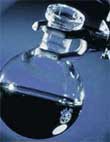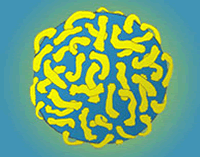 Our solution was inspired by anti-cancer research. Today, scientists are trying to find a way to avoid the negative effects of chemo therapy by delivering the toxic cancer-killing drugs directly to the cancer site instead of to the entire body. We met with researchers at the OSU College of Pharmacy who are using nano-sized, spherical liposomes to encapsulate the anti-cancer drugs before sending them into the blood stream.
Our solution was inspired by anti-cancer research. Today, scientists are trying to find a way to avoid the negative effects of chemo therapy by delivering the toxic cancer-killing drugs directly to the cancer site instead of to the entire body. We met with researchers at the OSU College of Pharmacy who are using nano-sized, spherical liposomes to encapsulate the anti-cancer drugs before sending them into the blood stream.  The drug-filled liposomes only deliver their load when receptors built into the liposomes latch onto the cancer site.
The drug-filled liposomes only deliver their load when receptors built into the liposomes latch onto the cancer site.
We realized through later research that we could use a similar method to encapsulate insulin, and cover the liposomes with receptors that would need to bind to glucose before releasing the insulin. We confirmed our theory by showing it to leading experts on nanotechnology and diabetes, and receiving their approval and encouragement.
Our first challenge was finding a way to deliver the liposomes of our Nano Mist into the diabetic's blood stream without an injection. Unlike delivery of insulin itself, delivery of our insulin-filled liposomes wouldn't need to be timely. Because the liposomes only start to release insulin when glucose levels rise, a patient could deliver a month's supply into the blood stream all at once.
 Our first idea was to deliver the liposomes via a pill that was designed to be able to pass through the stomach and small intestine and deliver the liposomes directly to the blood stream. Normal pills deliver their drugs to the
Our first idea was to deliver the liposomes via a pill that was designed to be able to pass through the stomach and small intestine and deliver the liposomes directly to the blood stream. Normal pills deliver their drugs to the stomach or sometimes the small intestine, but if our liposomes were delivered to either of those areas they would be destroyed. We designed a pill that used multiple stages of pH sensitive polymer coating to evade the low pH environment of the stomach and then the high pH environment of the small intestine, but based on feedback from experts in the nanotechnology medical field, we realized we couldn't prevent the liposomes from being digested if delivered via a pill. We decided to look for other ideas.
stomach or sometimes the small intestine, but if our liposomes were delivered to either of those areas they would be destroyed. We designed a pill that used multiple stages of pH sensitive polymer coating to evade the low pH environment of the stomach and then the high pH environment of the small intestine, but based on feedback from experts in the nanotechnology medical field, we realized we couldn't prevent the liposomes from being digested if delivered via a pill. We decided to look for other ideas.
Next we looked into using an inhaler to deliver the liposomes through the lungs, but because there was a high risk of the liposomes irritating the bronchioles, we decided that the best idea was a nasal inhalant. The nasal cavity is the fastest and safest path directly to the blood stream.

 To learn more about the concept of nanoencapsulation, we met with researchers from the Ohio State University College of Pharmacy. They are currently using liposomes to nanoencapsulate anti-cancer drugs.
To learn more about the concept of nanoencapsulation, we met with researchers from the Ohio State University College of Pharmacy. They are currently using liposomes to nanoencapsulate anti-cancer drugs.
The researchers assisted us in making our own liposomes. With the right ingredients in a test vial (lipids, cholesterol, water, and ethanol), the hydrophobic (water resisting) and hydrophilic (water loving) properties of the substances will cause liposomes to self-assemble. The liposomes will encapsulate whatever drug is added to the mixture.

 Our solution was inspired by anti-cancer research. Today, scientists are trying to find a way to avoid the negative effects of chemo therapy by delivering the toxic cancer-killing drugs directly to the cancer site instead of to the entire body. We met with researchers at the OSU College of Pharmacy who are using nano-sized, spherical liposomes to encapsulate the anti-cancer drugs before sending them into the blood stream.
Our solution was inspired by anti-cancer research. Today, scientists are trying to find a way to avoid the negative effects of chemo therapy by delivering the toxic cancer-killing drugs directly to the cancer site instead of to the entire body. We met with researchers at the OSU College of Pharmacy who are using nano-sized, spherical liposomes to encapsulate the anti-cancer drugs before sending them into the blood stream.  The drug-filled liposomes only deliver their load when receptors built into the liposomes latch onto the cancer site.
The drug-filled liposomes only deliver their load when receptors built into the liposomes latch onto the cancer site.  Our first idea was to deliver the liposomes via a pill that was designed to be able to pass through the stomach and small intestine and deliver the liposomes directly to the blood stream. Normal pills deliver their drugs to the
Our first idea was to deliver the liposomes via a pill that was designed to be able to pass through the stomach and small intestine and deliver the liposomes directly to the blood stream. Normal pills deliver their drugs to the stomach or sometimes the small intestine, but if our liposomes were delivered to either of those areas they would be destroyed. We designed a pill that used multiple stages of pH sensitive polymer coating to evade the low pH environment of the stomach and then the high pH environment of the small intestine, but based on feedback from experts in the nanotechnology medical field, we realized we couldn't prevent the liposomes from being digested if delivered via a pill. We decided to look for other ideas.
stomach or sometimes the small intestine, but if our liposomes were delivered to either of those areas they would be destroyed. We designed a pill that used multiple stages of pH sensitive polymer coating to evade the low pH environment of the stomach and then the high pH environment of the small intestine, but based on feedback from experts in the nanotechnology medical field, we realized we couldn't prevent the liposomes from being digested if delivered via a pill. We decided to look for other ideas. 
 To learn more about the concept of nanoencapsulation, we met with researchers from the Ohio State University College of Pharmacy. They are currently using liposomes to nanoencapsulate anti-cancer drugs.
To learn more about the concept of nanoencapsulation, we met with researchers from the Ohio State University College of Pharmacy. They are currently using liposomes to nanoencapsulate anti-cancer drugs.